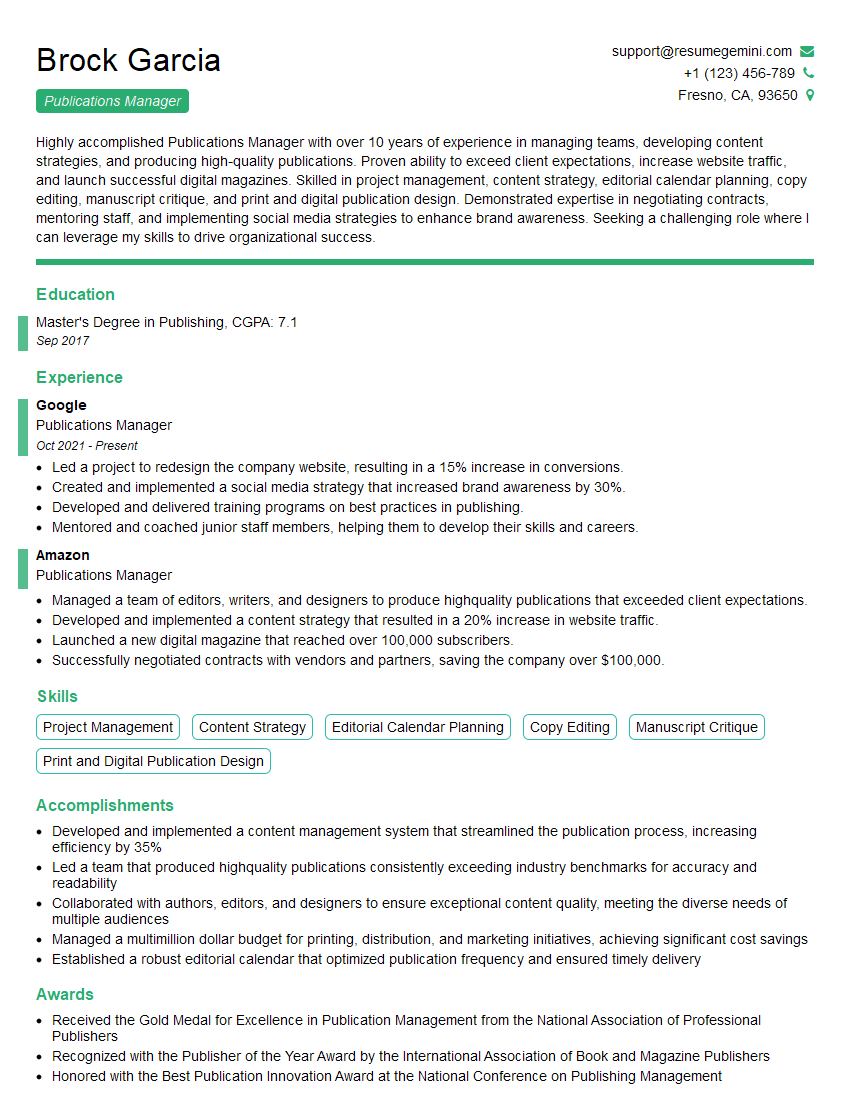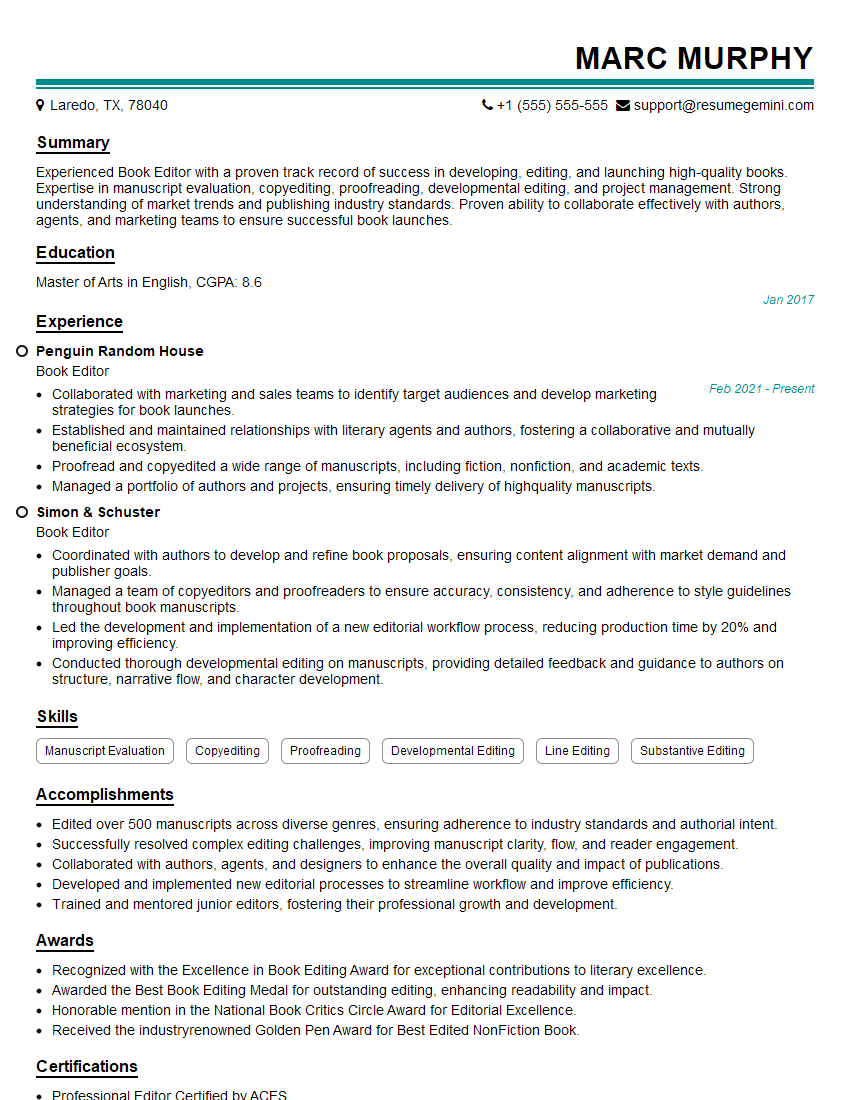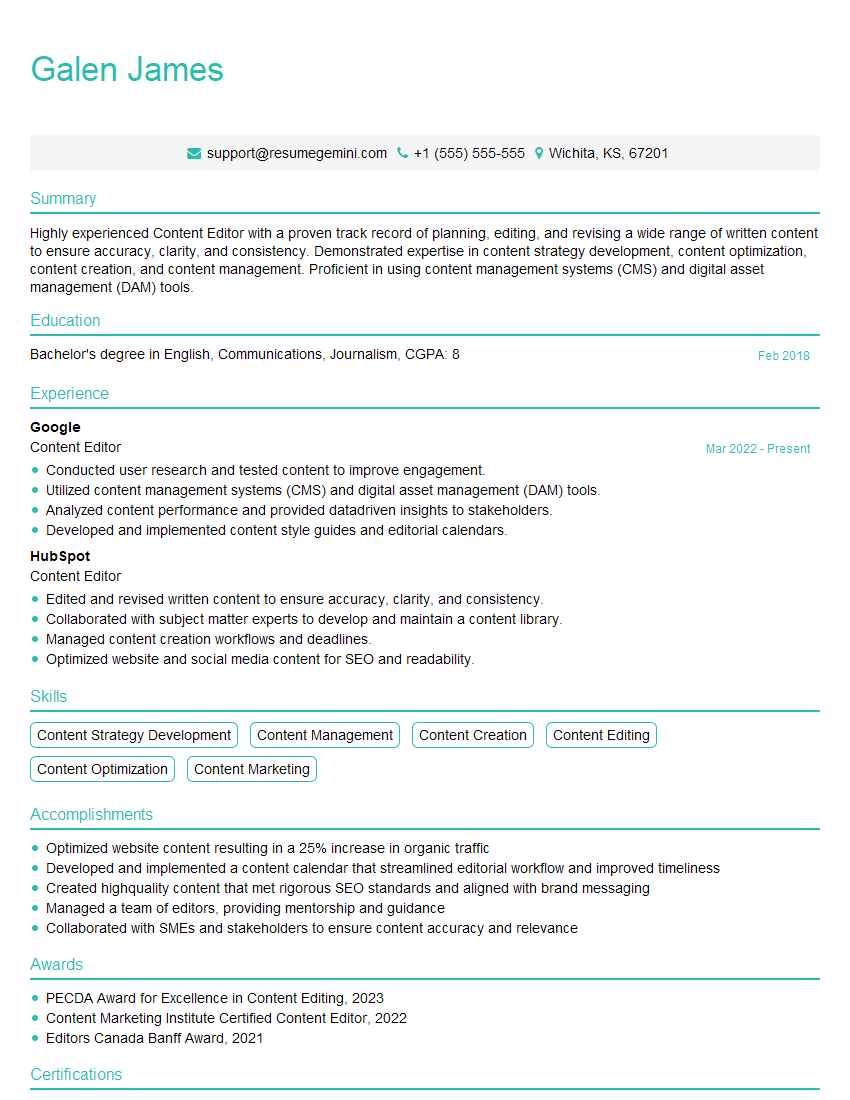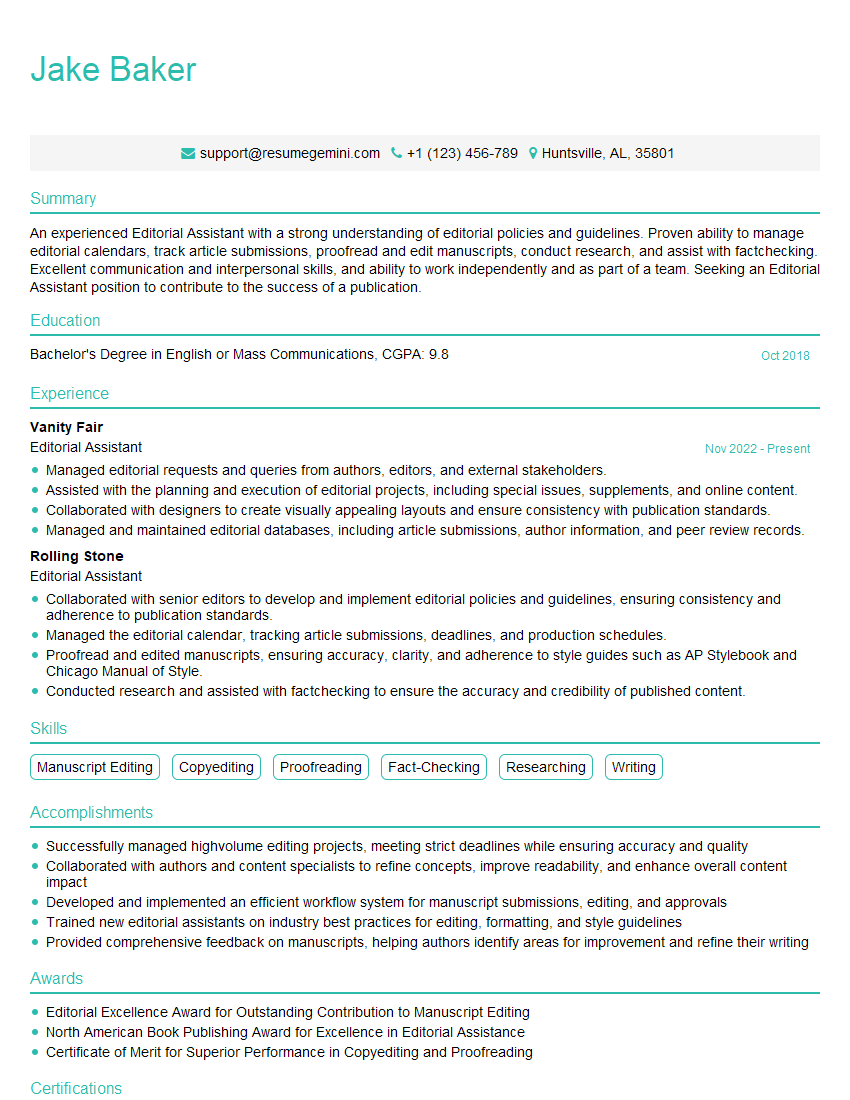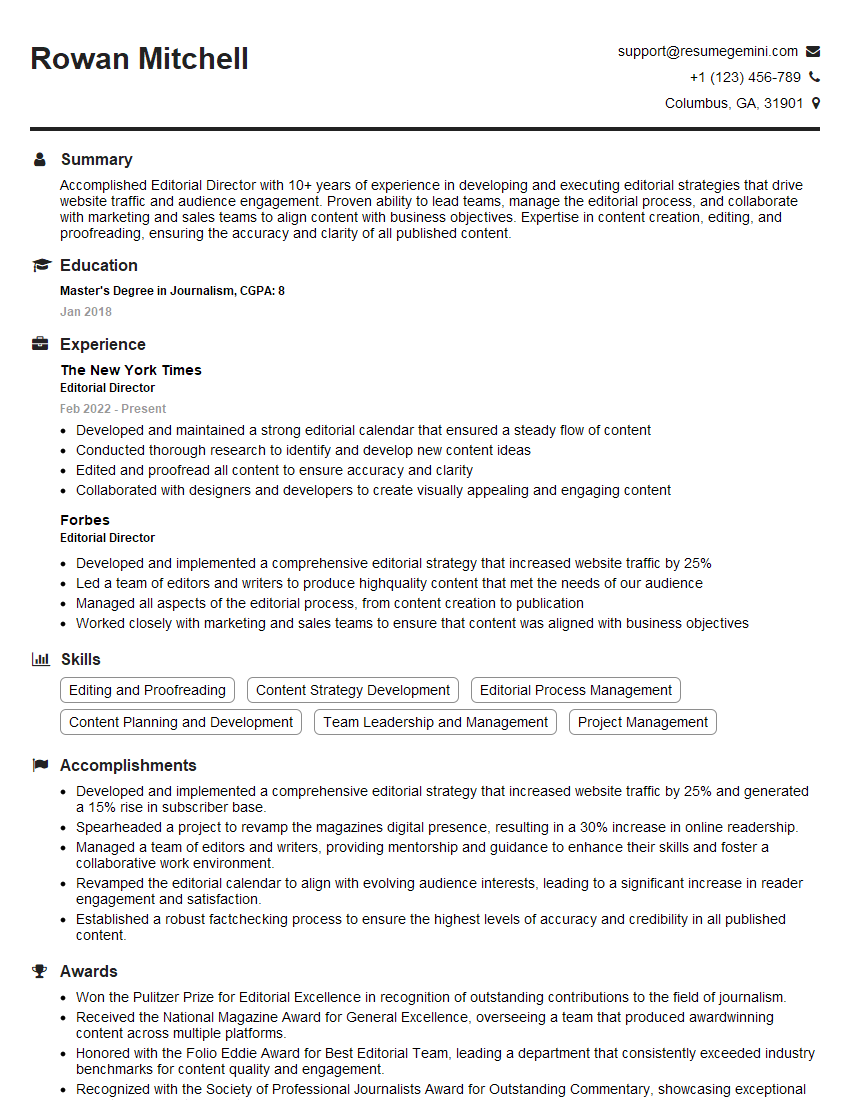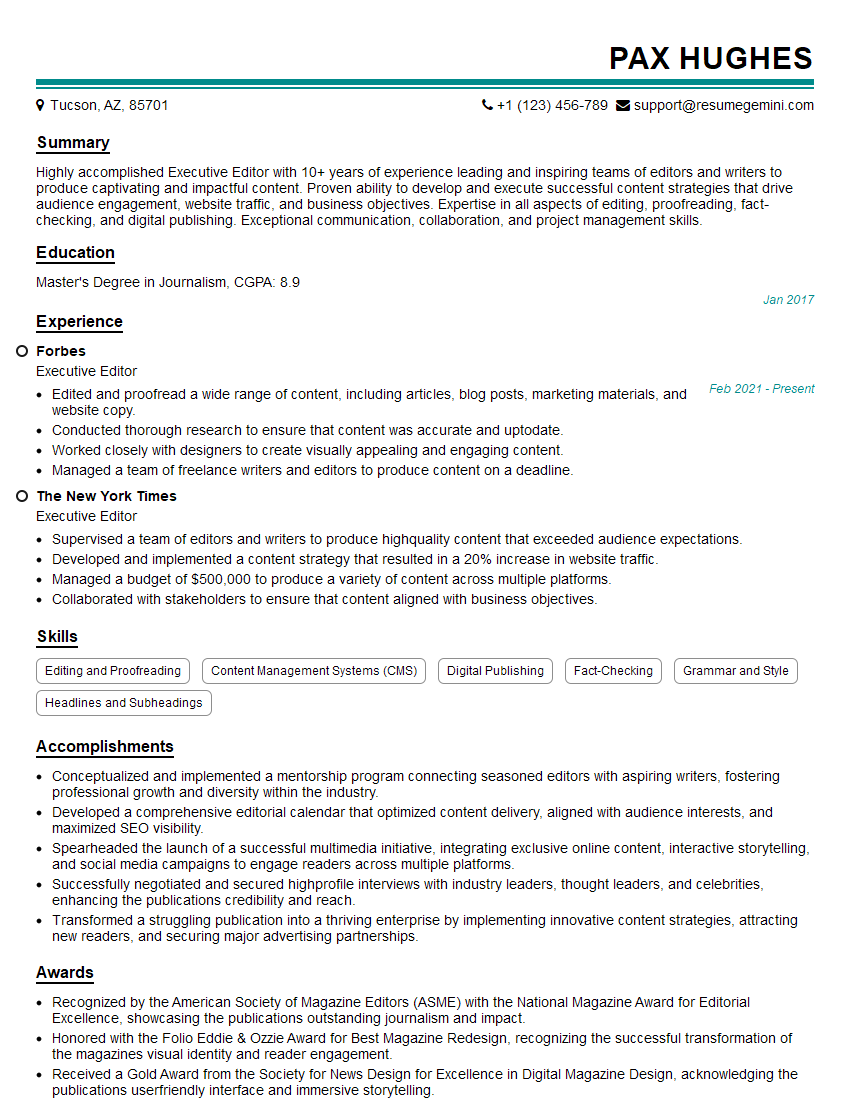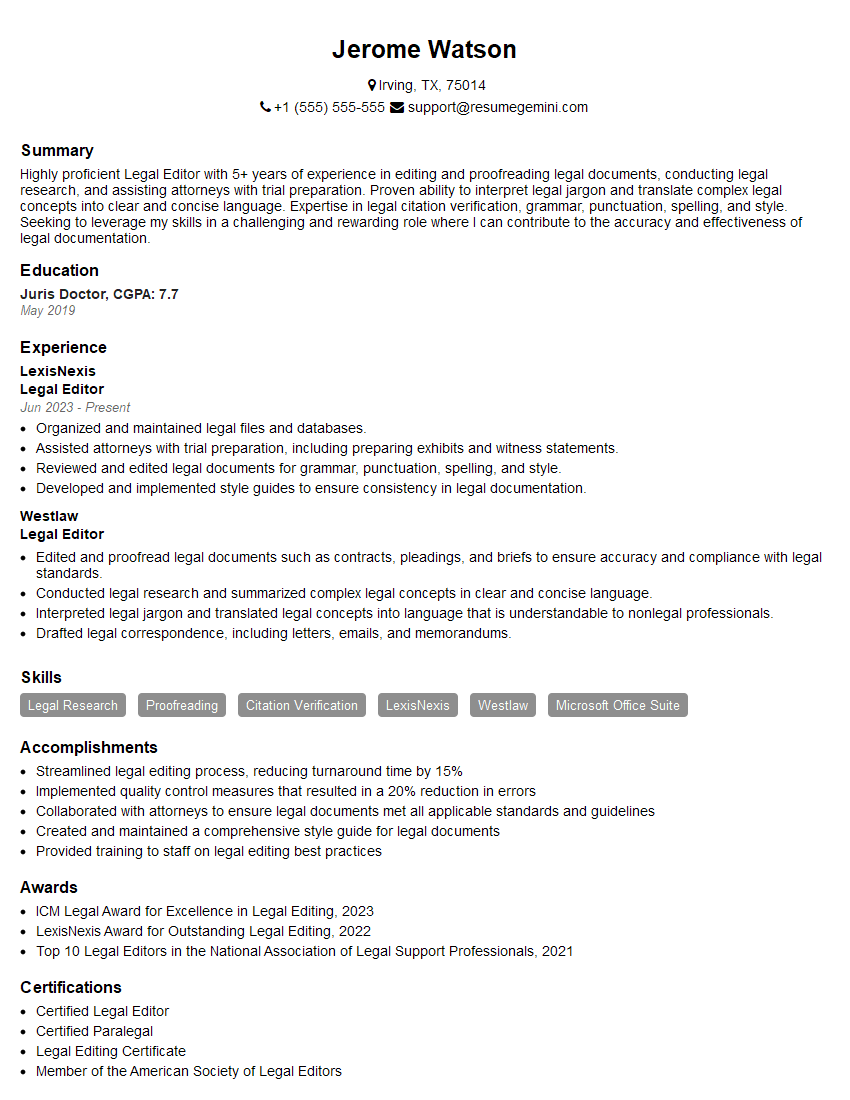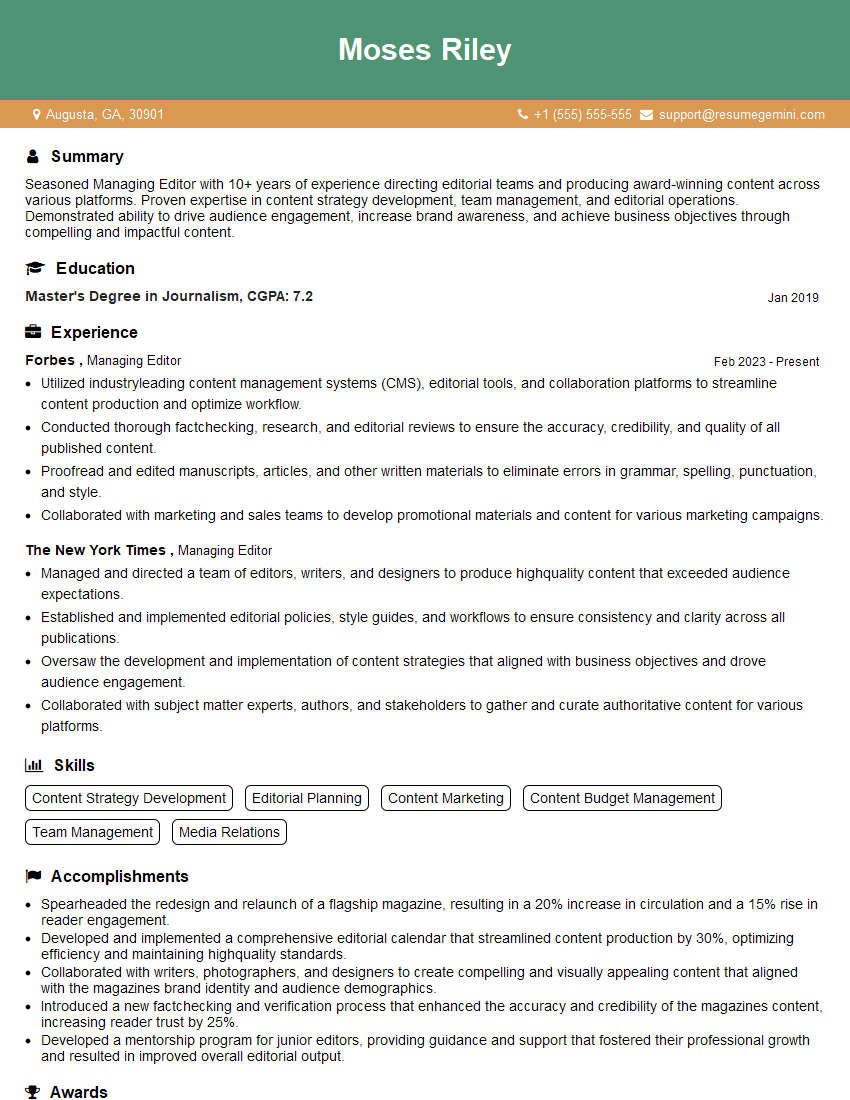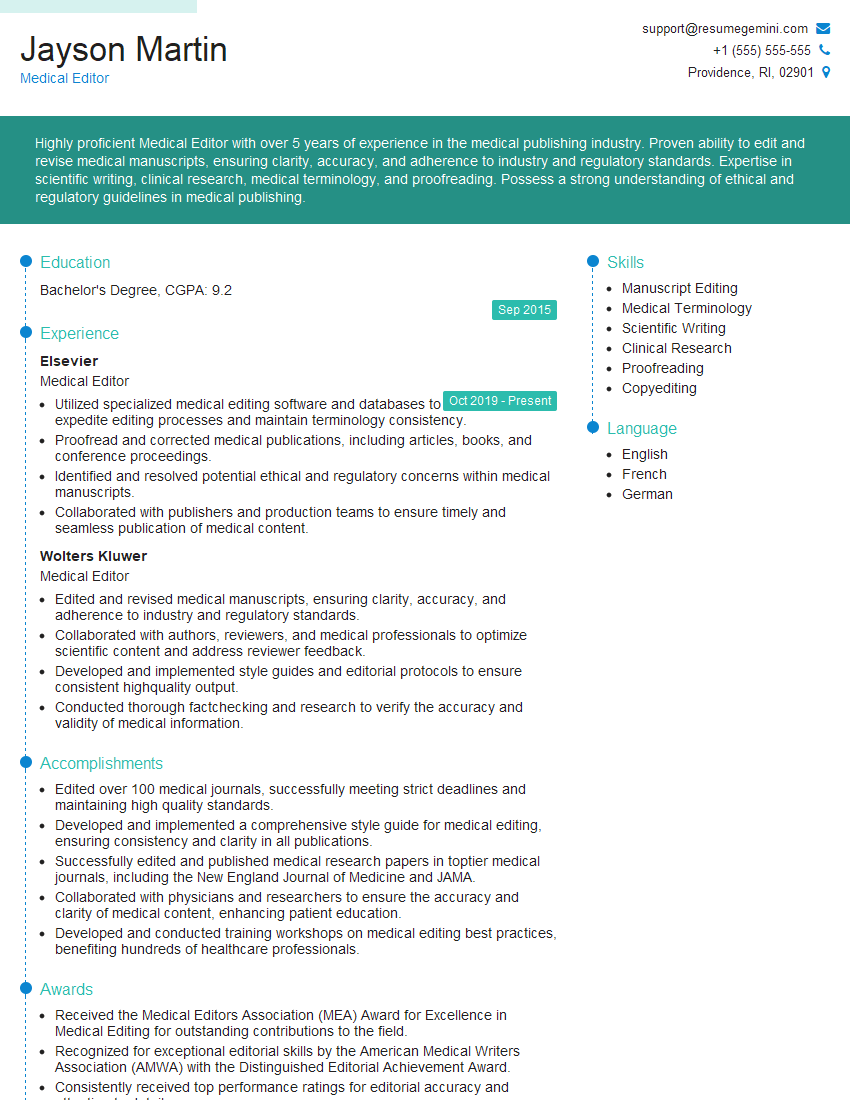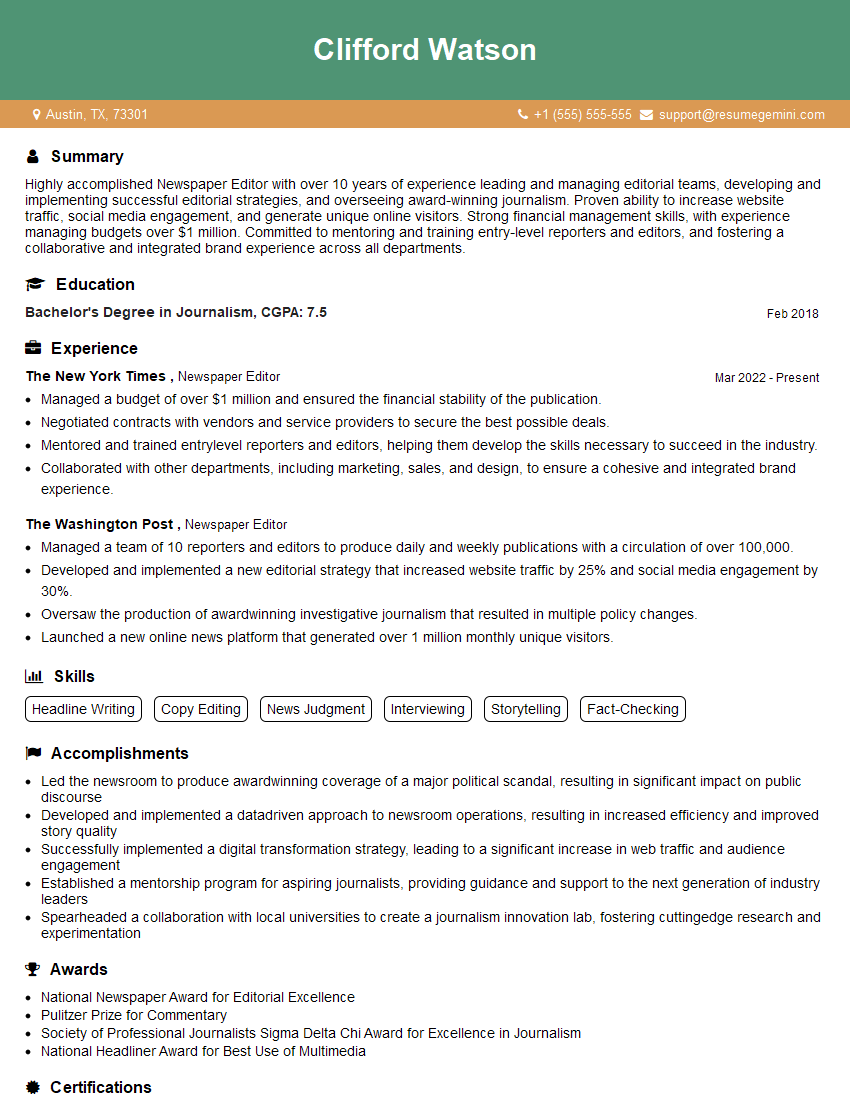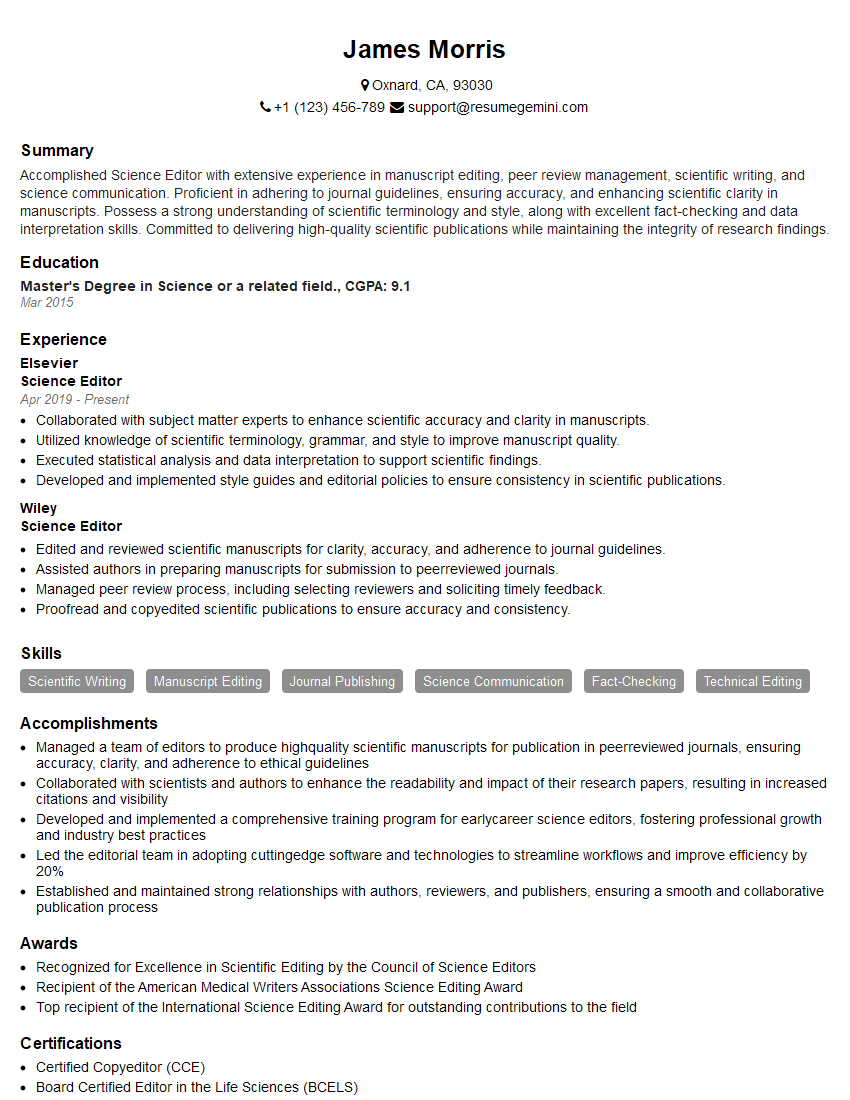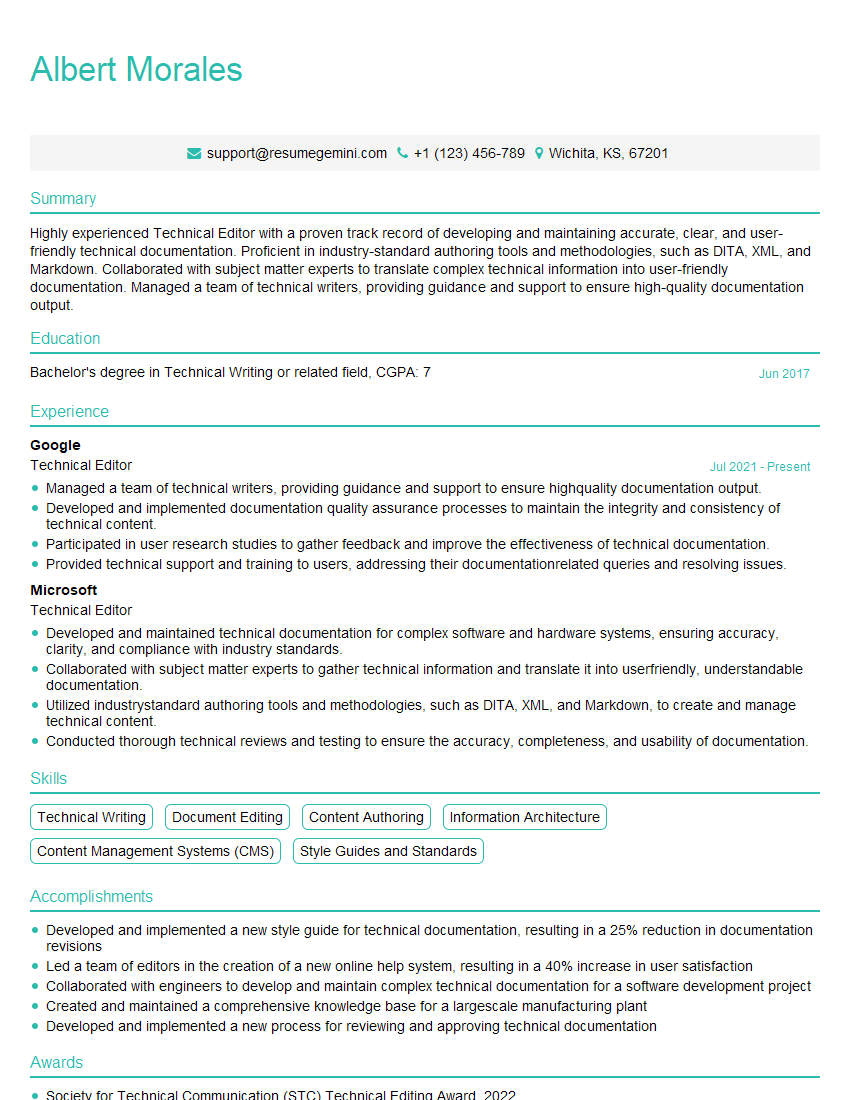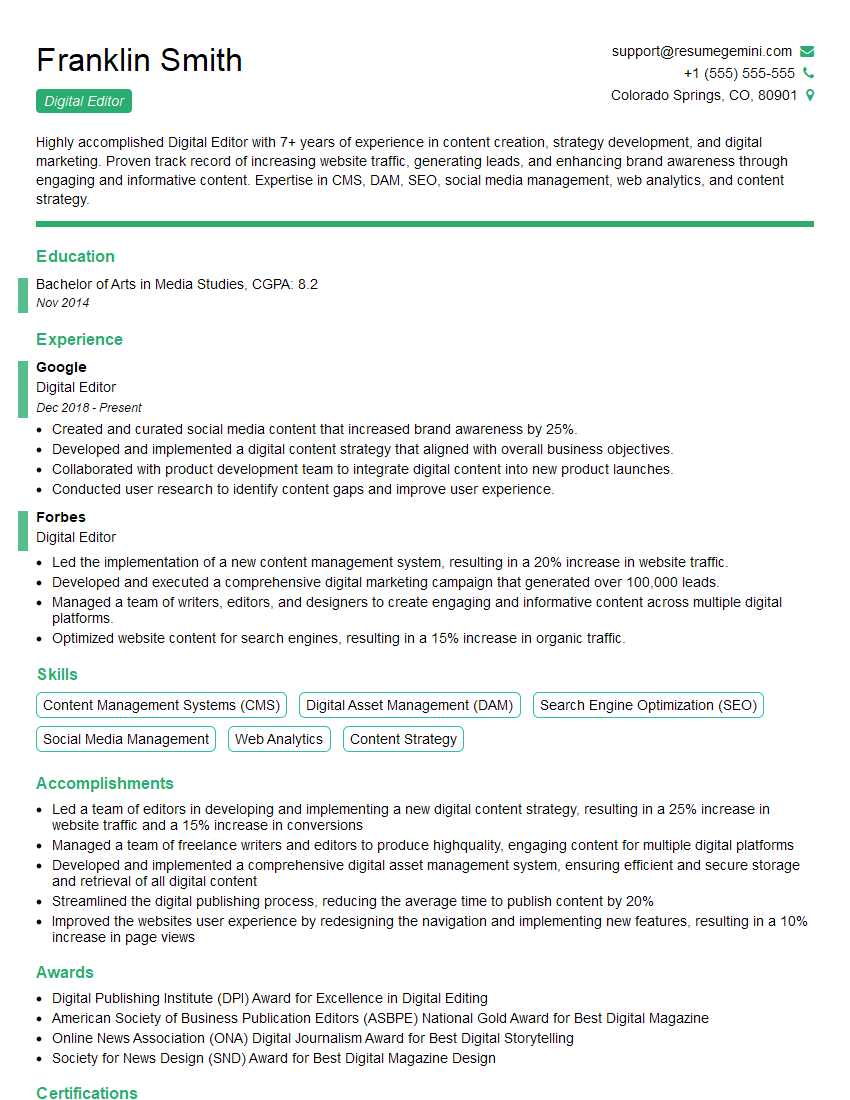Feeling uncertain about what to expect in your upcoming interview? We’ve got you covered! This blog highlights the most important Communicating with Editors interview questions and provides actionable advice to help you stand out as the ideal candidate. Let’s pave the way for your success.
Questions Asked in Communicating with Editors Interview
Q 1. Describe your experience working with different editor personalities.
Throughout my career, I’ve collaborated with a diverse range of editors, each with their unique working style and personality. Some prefer highly detailed, meticulous feedback delivered in multiple stages, while others favor a more concise, big-picture approach. For instance, I worked with one editor who thrived on detailed grammatical edits and stylistic consistency, meticulously reviewing every comma. Another preferred a broader, conceptual review, focusing on the overall narrative flow and argument strength. Understanding these preferences is key. I adapt my communication style to match their working method – providing detailed reports for detail-oriented editors and concise summaries for those who prefer a broader overview. This adaptability ensures smoother workflows and better communication.
Q 2. How do you handle conflicting feedback from multiple editors?
Conflicting feedback is a common challenge. My approach is systematic. First, I carefully analyze each editor’s comments, identifying points of agreement and disagreement. Then, I prioritize feedback based on its impact on the overall piece. For example, concerns about factual accuracy or major structural issues usually take precedence over stylistic suggestions. If the conflicts are substantial, I initiate a discussion with the editors, explaining my understanding of the feedback and proposing potential solutions. Often, a simple clarification call can resolve apparent inconsistencies. If consensus can’t be reached, I explain my rationale for choosing a specific course of action and clearly document the decisions made, ensuring transparency with all parties involved. Think of it like a referee mediating a disagreement – fairness and clear communication are key.
Q 3. Explain your process for incorporating editorial changes into your work.
My process for incorporating editorial changes is meticulous and transparent. I always track changes using a version control system, like Git or a simple track-changes feature in a word processor. This allows me to review the changes systematically and ensure I understand the reasoning behind each edit. I then respond to each comment individually, often using the comment feature itself to clarify my understanding or ask for further explanation if needed. For major revisions, I provide a summary of the changes implemented and highlight any areas where I chose a different approach and explain my reasoning. This approach fosters open communication and ensures the final product reflects a collaborative effort.
Q 4. How do you manage your time when facing tight deadlines from editors?
Tight deadlines require effective time management. My strategy involves breaking down the editing process into smaller, manageable tasks. I create a detailed timeline outlining each task with realistic deadlines. This could involve creating a simple spreadsheet or using a project management tool. I prioritize tasks based on urgency and impact, focusing first on crucial elements that must be addressed before others. Communication is vital; I proactively update the editor on my progress and inform them immediately of any potential delays. It’s all about clear communication and efficient task prioritization. It’s like assembling a complex puzzle – one piece at a time, with careful attention to the final picture.
Q 5. How would you respond to an editor’s request for significant revisions?
A request for significant revisions is an opportunity for improvement. My response is always professional and collaborative. First, I carefully review the editor’s feedback, identifying the core issues. Then, I propose a plan to address the revisions, outlining the timeline and steps involved. I don’t hesitate to ask clarifying questions if I need more information. I might say something like, “Thank you for your detailed feedback. To ensure I fully understand the requested changes, could you elaborate on point X?” Transparency and collaboration are key to navigating such challenges successfully. Remember, a constructive dialogue is essential to a positive outcome.
Q 6. What strategies do you use to maintain a professional and productive relationship with editors?
Maintaining a positive working relationship with editors is paramount. I prioritize clear and timely communication, responding promptly to emails and requests. I strive to be proactive, anticipating potential issues and addressing them before they escalate. I also make a point of valuing their expertise and feedback, acknowledging their contributions and expressing my appreciation for their guidance. Regular check-ins and a willingness to collaborate fosters mutual respect and a productive workflow. Think of it as building a strong bridge – communication, mutual respect, and collaboration are the pillars.
Q 7. How do you prioritize multiple editing tasks with competing deadlines?
Prioritizing multiple editing tasks with competing deadlines involves a strategic approach. I use a prioritization matrix, considering factors like urgency, impact, and deadline proximity. I assign each task a priority level and schedule them accordingly. Timeboxing helps to allocate dedicated time slots for each task, preventing task switching and improving focus. For urgent tasks, I might allocate more time or request extensions if needed, ensuring open communication with clients and editors to manage expectations. This method helps me manage my workload effectively, ensuring deadlines are met and all tasks receive appropriate attention.
Q 8. Explain how you handle constructive criticism from editors.
Constructive criticism is crucial for growth. I approach it as an opportunity to refine my work and learn from experienced professionals. My process involves:
- Active Listening: I carefully read the editor’s comments, ensuring I understand their perspective fully before reacting.
- Seeking Clarification: If anything is unclear, I reach out to the editor for clarification, avoiding assumptions. For example, if an editor notes a ‘lack of clarity’ in a section, I would ask for specific examples of what they found unclear.
- Strategic Implementation: I systematically address each point raised, weighing the editor’s suggestions against the overall piece’s integrity and audience. Sometimes, a compromise is necessary. I might adjust the wording, add supporting evidence, or restructure a paragraph, depending on the feedback.
- Professional Communication: I respond to the editor in a timely manner, demonstrating professionalism and a willingness to collaborate. I express my gratitude for their input and explain my rationale for any changes (or non-changes) to my work.
For example, if an editor suggested removing a particular anecdote, I’d consider whether it truly adds value or if it detracts from the main argument. If it’s the latter, I’d happily remove it. If it’s crucial to the narrative and its removal would significantly weaken the piece, I would explain this to the editor and discuss alternative solutions, perhaps by rephrasing or shortening it.
Q 9. How do you ensure your work adheres to specific style guides and editorial standards?
Adhering to style guides is paramount for maintaining consistency and professionalism. My approach involves:
- Thorough Review: I carefully read the style guide provided before beginning any work, noting any unfamiliar aspects or nuances. Many guides have online versions easily searchable for quick reference.
- Consistent Application: I diligently apply the guide’s rules throughout my writing, paying close attention to details such as capitalization, punctuation, citation formats (e.g., APA, Chicago), and formatting conventions.
- Use of Style Checkers: I utilize automated style checkers, such as those built into word processors, to identify inconsistencies in style early on. However, I always treat them as a first pass, relying on my own careful proofreading and attention to detail.
- Double-Checking: Before submitting my work, I conduct a final review to ensure complete adherence to the guide, including headings, subheadings, and even spacing.
For instance, if the style guide mandates using ‘British English’ spelling, I ensure words like ‘colour’ and ‘analyse’ are used consistently, not ‘color’ and ‘analyze’.
Q 10. Have you ever had to disagree with an editor’s decision? How did you approach the situation?
Disagreements with editors are a natural part of the process. My approach prioritizes respect and finding common ground. I would:
- Understand the Rationale: I would first try to understand the editor’s reasoning behind their decision. Sometimes, there’s a justifiable reason that I hadn’t considered.
- Politely Present my Perspective: I would politely and professionally explain my point of view, providing concrete evidence or arguments to support my position. For example, I might explain how a suggested change would weaken the argument or confuse the reader.
- Collaboration & Compromise: I am open to finding a compromise that respects both our perspectives. This could involve modifying my original approach to address the editor’s concerns while preserving the essence of my work.
- Accepting the Final Decision: Ultimately, the editor has the final say. If, after discussion, we cannot reach an agreement, I will respectfully accept their decision, knowing that their judgment reflects their experience and the overall publication’s standards.
In one instance, I disagreed with an editor’s decision to cut a significant portion of background information. After explaining how this context was crucial for the reader’s understanding, we worked together to condense the information without losing its essential elements, addressing the editor’s concern about length.
Q 11. Describe your experience working with automated editing tools.
Automated editing tools are valuable aids, but they are not a substitute for human judgment. I use them as a first line of defense in catching errors and inconsistencies in:
- Grammar and Spelling: Tools like Grammarly or ProWritingAid flag potential grammatical errors and spelling mistakes. This saves time and allows me to focus on higher-level aspects of editing.
- Style and Consistency: Certain tools can help maintain consistency in formatting, tone, and style, although you need to be careful to customize them to match specific style guides.
- Plagiarism Detection: Tools such as Turnitin are helpful in ensuring the originality of the content, especially important in academic writing.
However, I am aware of their limitations. They cannot always understand the nuances of language or the context, so I always manually review their suggestions before making changes. Over-reliance on these tools can lead to unnatural phrasing or loss of the author’s voice. I find them most useful as a first check, then rely on my critical thinking for final review.
Q 12. How do you ensure clarity and accuracy in your writing for different target audiences?
Clarity and accuracy are essential for effective communication. Tailoring my writing to specific audiences involves:
- Audience Analysis: Before writing, I thoroughly research the target audience to understand their knowledge level, interests, and expectations. This shapes my language, tone, and style.
- Appropriate Language: I avoid jargon and technical terms unless the audience is familiar with them. I aim for simple, concise language that is easy to understand.
- Clear Structure: I organize my writing logically, using clear headings, subheadings, and transitions to guide the reader. This improves comprehension and readability.
- Fact-Checking and Verification: I meticulously check all facts and figures to ensure accuracy. I rely on credible sources and double-check information to avoid errors.
For instance, when writing for a scientific journal, I would use precise and technical language, while writing for a general audience would necessitate a simpler, more accessible style. This nuanced approach ensures the message resonates effectively with the intended readership.
Q 13. How familiar are you with various editorial workflows and processes?
I’m highly familiar with various editorial workflows and processes, including:
- Traditional Publishing Workflow: I understand the stages involved in traditional publishing, from manuscript submission to final publication, including developmental editing, copyediting, proofreading, and typesetting.
- Digital Publishing Workflow: I’m proficient in the digital publishing workflow, understanding the nuances of online content creation, SEO optimization, and content management systems.
- Collaborative Platforms: I’m comfortable using collaborative platforms like Google Docs or Microsoft SharePoint for seamless collaboration with editors and other stakeholders.
- Agile Editing: I’m familiar with agile methodologies in editing, enabling quick iterations and responsive adjustments to feedback.
My experience spans various environments, from academic publishing to corporate communications, allowing me to adapt to different workflows seamlessly.
Q 14. How do you identify and rectify inconsistencies in a manuscript or article?
Identifying and rectifying inconsistencies is critical for maintaining quality. My strategy includes:
- Multiple Reads: I conduct multiple readings of the manuscript or article, focusing on different aspects each time (grammar, style, factual accuracy, consistency of terminology).
- Style Guides and Checklists: I use style guides and checklists as references to identify deviations from established standards.
- Automated Tools: I leverage automated tools to highlight potential inconsistencies in grammar, spelling, style, and formatting.
- Cross-Referencing: I cross-reference information throughout the manuscript to ensure consistency in facts, figures, and terminology.
- Creating a Style Sheet: For large projects, I create a style sheet to document consistent formatting, terminology, and other style choices to guide editing and ensure uniformity.
For instance, if I find inconsistent use of a particular term, I would create a list of every instance, evaluate the context of each use, and then standardize the term throughout the piece.
Q 15. Describe your experience with fact-checking and verifying information.
Fact-checking and verification are crucial for maintaining journalistic integrity. My approach involves a multi-layered process. First, I identify claims needing verification, then I cross-reference information from multiple reputable sources – ideally, primary sources when available. This might involve checking government records, academic journals, reputable news organizations, or interviewing experts. I meticulously document all sources used. I also look for inconsistencies or contradictions in the information, and if any exist, I investigate further. For example, if an article cites a statistic, I’d go to the original study or report to confirm its accuracy and context. Finally, I maintain a detailed log of my fact-checking process, including the sources consulted and any discrepancies found, to ensure transparency and accountability.
Imagine a situation where an article claims a specific number of people attended a protest. I wouldn’t just accept that number at face value. I’d look for independent reports from news agencies covering the event, maybe even reviewing official police statements or social media analytics (used cautiously, of course) to corroborate the attendance figures. Discrepancies would prompt further investigation to resolve any conflicts and reach an accurate representation of the facts.
Career Expert Tips:
- Ace those interviews! Prepare effectively by reviewing the Top 50 Most Common Interview Questions on ResumeGemini.
- Navigate your job search with confidence! Explore a wide range of Career Tips on ResumeGemini. Learn about common challenges and recommendations to overcome them.
- Craft the perfect resume! Master the Art of Resume Writing with ResumeGemini’s guide. Showcase your unique qualifications and achievements effectively.
- Don’t miss out on holiday savings! Build your dream resume with ResumeGemini’s ATS optimized templates.
Q 16. Explain your method for proofreading and identifying errors in text.
My proofreading method is systematic and thorough. I typically employ multiple passes, each with a specific focus. The first pass checks for grammar and mechanics – subject-verb agreement, punctuation, spelling, and sentence structure. The second pass focuses on style and consistency – ensuring consistent use of capitalization, formatting, and tone. A final pass involves a broader check for clarity, logic, and flow of the text. I often use tools like Grammarly to assist in identifying common errors, but I always review its suggestions carefully, as it isn’t foolproof. I also benefit from reading the text aloud, as it helps catch awkward phrasing or grammatical mistakes that might be missed when reading silently.
For example, if I’m editing a scientific paper, I’ll pay extra attention to the precise use of terminology and ensure the citations are accurate and formatted according to the journal’s style guide. A simple typo in a medical article could have serious consequences, highlighting the vital importance of rigorous proofreading.
Q 17. How do you effectively communicate the rationale behind your editorial decisions?
Communicating the rationale behind editorial decisions is key to building trust and fostering a collaborative environment. I explain my edits clearly and concisely, focusing on the underlying principles. I avoid being overly critical and instead frame my suggestions as improvements that aim to enhance clarity, accuracy, or style. I always provide specific examples to illustrate my points. For instance, if I change a sentence structure, I explain why the original was unclear and how the revision improves its readability. If I suggest removing a section, I’ll explain why it’s irrelevant or redundant to the overall article.
For instance, if I changed a passive sentence like “The report was written by John” to an active sentence “John wrote the report”, I would explain that the active voice is more direct and concise, leading to a better flow and reader experience. I might even provide a reference to a style guide that supports this preference.
Q 18. How do you prioritize tasks when facing conflicting editor requests?
Prioritizing conflicting editor requests requires careful consideration and communication. I begin by understanding the urgency and importance of each task, factoring in deadlines and the potential impact of delays. I might use a simple prioritization matrix, rating each task based on urgency and importance. This helps me visually organize and determine which task to tackle first. Open and honest communication with the editors is crucial. If deadlines conflict, I explain the situation and propose a revised schedule, negotiating to find a solution that satisfies everyone’s needs.
For example, if one editor needs a piece proofread urgently for an immediate publication, while another has a less time-sensitive request, I prioritize the urgent one, keeping the other editor informed about the progress and the anticipated completion time. Transparency is key to maintaining good working relationships.
Q 19. How do you adapt your communication style to different editor preferences?
Adapting my communication style is essential for effective collaboration. I observe each editor’s preferred communication style—some prefer detailed explanations, others prefer concise feedback. Some prefer email, others instant messaging. I tailor my approach accordingly, ensuring my communication is clear, respectful, and reflects their preferences. For example, if an editor prefers a more formal tone, I ensure my emails are professional and well-structured. If an editor is more direct, I will be clear and to-the-point in my communication, avoiding unnecessary details.
I’ve found that actively listening to how editors communicate and asking clarifying questions early on is a very effective way to identify their style preferences. This allows for a more efficient and productive collaboration.
Q 20. Describe your experience with collaborating remotely with editors.
My experience with remote collaboration is extensive. Effective remote communication relies on proactive engagement and utilizing appropriate tools. I rely on project management software (like Asana or Trello) to track progress, share files, and maintain a clear record of communication. Consistent and clear communication through email, instant messaging, or video conferencing is essential to avoid misunderstandings. I also proactively seek clarification if anything is unclear, ensuring that we’re all on the same page. I maintain a professional and courteous tone in all my communications, ensuring that my messages are concise, and I always acknowledge receipt of messages and requests promptly.
For example, when working on a large project with multiple editors, using a shared online document with version history has proven invaluable. It allows everyone to see the changes made, avoid duplication of effort and provide detailed feedback without creating confusing email chains.
Q 21. How do you proactively anticipate and address potential editorial concerns?
Anticipating and addressing potential editorial concerns is a proactive approach that saves time and improves the overall workflow. I carefully review the material before submitting it, considering potential issues from the editor’s perspective. This includes looking for potential ambiguities, inconsistencies, or areas that may require further clarification. I also make sure that the material adheres to the style guide and the publication’s standards. If I anticipate a potential issue, I address it preemptively by providing a clear explanation or alternative solution in my communication with the editor.
For example, if I’m writing an article about a complex scientific concept, I would anticipate that the editor might have questions about its technical accuracy. To proactively address this, I might include a brief explanation of the concept alongside links to reputable resources or provide the names of experts I have consulted.
Q 22. Describe your experience with managing feedback from editors through various platforms (email, track changes, etc.)
Managing editor feedback across various platforms is crucial for efficient collaboration. My experience encompasses seamless integration of feedback from email threads, track changes in documents (like Microsoft Word or Google Docs), and online collaborative platforms such as Google Workspace or dedicated project management tools like Asana.
For email, I maintain detailed records of all correspondence, using clear subject lines and numbered points to address each comment. This ensures nothing gets missed. For track changes, I carefully review each suggestion, accepting or rejecting them with comments explaining my rationale. If clarification is needed, I directly reply to the editor’s comment within the document itself. This keeps the communication thread within the document, making it easier to track revisions. Finally, using collaborative platforms allows for real-time feedback and quick resolution of queries, improving turnaround times.
For example, in a recent project involving a lengthy research paper, the editor used track changes extensively. By replying to each comment within the document and asking clarifying questions when necessary, I ensured we were both on the same page and significantly reduced the number of email exchanges required.
Q 23. How do you handle requests for revisions outside of your initial scope of work?
Requests for revisions beyond the initial scope are handled professionally and transparently. I begin by acknowledging the request and clearly stating the impact on the timeline and budget. I’ll assess if the revisions align with the project’s overall goals and the intended audience.
If the revisions are crucial and feasible, I’ll discuss the added time and costs involved with the editor, providing a detailed breakdown of the necessary work and agreeing on a revised timeline and budget. I always keep detailed records of this negotiation and any resulting agreement. If the requested revisions are not feasible within the constraints of the project, I’ll explain my reasons clearly and propose alternative solutions or compromises. This involves a collaborative discussion to find the best possible outcome that is both realistic and satisfies the editorial needs.
For instance, I once received a request to add a substantial section to a blog post after the initial deadline. While it was outside the original scope, the revision was important to the post’s accuracy. I explained the extra time it would take and provided a revised timeline, which the editor approved.
Q 24. Describe your experience with working on projects with multiple contributors under the guidance of an editor.
Collaborating with multiple contributors under an editor’s guidance requires strong organizational skills and excellent communication. I leverage project management tools to ensure smooth workflows. These tools facilitate the sharing of drafts, tracking progress, and consolidating feedback from various sources. I’m adept at facilitating discussion among contributors, ensuring that all voices are heard and that the final product reflects a cohesive narrative.
To keep things organized, I often create a central document or shared drive with clearly defined folders for different sections or stages of the project. This makes it easy for everyone to access the necessary materials and understand their responsibilities. Regular check-in meetings with the editor and contributors ensure everyone stays on track and addresses any potential roadblocks. Open communication is key—I ensure that everyone is aware of deadlines and expectations.
In one project, we had three writers, a fact-checker, and a graphic designer all working together. By using a shared Google Drive and scheduling regular meetings, we were able to produce a high-quality ebook on time and within budget.
Q 25. How familiar are you with different publishing platforms and their editorial requirements?
I’m familiar with a wide range of publishing platforms and their editorial requirements, including academic journals, online magazines, book publishers, and self-publishing platforms. My experience covers different style guides (like Chicago, APA, MLA, etc.) and formatting specifications for each platform. I understand the nuances of each platform’s submission process, technical requirements, and the specific editorial preferences.
This understanding extends to digital platforms, including their content management systems (CMS) and specific technical requirements for image and video uploads, metadata, and SEO optimization. Understanding these platforms’ unique requirements ensures efficient and effective publication workflows and minimizes potential delays or rejections. I constantly update my knowledge to stay abreast of changes and new platforms.
Q 26. How do you track and manage the feedback provided by multiple editors?
Managing feedback from multiple editors requires a systematic approach. I use a combination of methods, often tailoring my approach to the specific project and the editors involved. I might utilize a dedicated project management tool to centralize all feedback or utilize color-coded track changes within the document to differentiate between editors’ comments.
Regardless of the chosen method, I always ensure that all comments are clearly attributed and easily accessible. I create a summary table or document that meticulously outlines each editor’s feedback, identifying common themes and areas of conflict. This organized approach ensures that all concerns are addressed and the final product meets the expectations of all involved editors. Using a detailed response system within track changes helps maintain a clear audit trail of all revisions and explanations.
Q 27. Explain your understanding of copyright and plagiarism issues in editorial work.
Copyright and plagiarism are critical considerations in editorial work. I have a thorough understanding of copyright law, including fair use principles, and the importance of obtaining necessary permissions for using copyrighted material. I’m adept at identifying potential plagiarism through various methods, including using plagiarism detection software and careful review of source materials.
My workflow includes proactively verifying the legitimacy of sources and ensuring that all used material is properly cited and attributed, adhering to the specified style guide. I understand the ethical implications of plagiarism and the legal consequences of copyright infringement, actively avoiding these issues to maintain professionalism and integrity.
Q 28. Describe a situation where you successfully navigated a challenging editorial process.
During a recent project involving a highly technical scientific paper, we encountered significant challenges with peer review. Two reviewers had drastically different opinions on the methodology and the interpretations of the results. This resulted in conflicting and extensive revisions requested.
To navigate this, I first created a detailed summary of the conflicting feedback, highlighting the core disagreements. I then engaged in detailed discussions with the lead author, clarifying their intentions and helping them respond point-by-point to each reviewer’s critique. I helped the author develop a strategy of responding that addressed the reviewers’ concerns and showcased the strengths of the study. The response incorporated elements from both sets of feedback, clarifying any misunderstandings and adding supplementary analyses where needed. Ultimately, this thorough and well-documented response led to the paper’s acceptance by the journal.
Key Topics to Learn for Communicating with Editors Interview
- Understanding Editorial Processes: Learn the stages of publishing, from manuscript submission to final publication. Understand the roles of different editorial team members (editors, fact-checkers, copyeditors, etc.).
- Effective Written & Verbal Communication: Practice concise and persuasive writing, tailoring your communication to different audiences (e.g., editors vs. general readers). Develop strong verbal communication skills for explaining your work and responding to feedback.
- Responding to Editorial Feedback: Learn how to professionally receive and implement constructive criticism. Develop strategies for addressing concerns and clarifying misunderstandings.
- Collaboration & Teamwork: Explore how to effectively collaborate with editors and other team members, demonstrating your ability to work within a team environment and meet deadlines.
- Understanding Copyright and Legal Considerations: Familiarize yourself with ethical considerations in publishing and the importance of adhering to copyright laws and editorial standards.
- Style Guides & AP Style: Mastering common style guides (e.g., AP Style) demonstrates attention to detail and professionalism. Practice applying these guidelines consistently.
- Proofreading & Editing Skills: Sharpen your proofreading abilities to identify grammatical errors, inconsistencies, and factual inaccuracies. Practice editing for clarity, conciseness, and style.
- Problem-Solving & Adaptability: Prepare examples illustrating how you’ve solved problems related to communication or collaboration in past experiences. Demonstrate your adaptability to different editorial styles and workflows.
Next Steps
Mastering communication with editors is crucial for a successful career in publishing, journalism, or any field requiring close collaboration with editorial teams. It showcases your professionalism, attention to detail, and ability to work effectively within a team. To significantly boost your job prospects, creating a strong, ATS-friendly resume is essential. ResumeGemini is a trusted resource that can help you build a professional resume tailored to your skills and experience. Examples of resumes tailored to Communicating with Editors roles are available within ResumeGemini to guide your creation process.
Explore more articles
Users Rating of Our Blogs
Share Your Experience
We value your feedback! Please rate our content and share your thoughts (optional).
What Readers Say About Our Blog
Interesting Article, I liked the depth of knowledge you’ve shared.
Helpful, thanks for sharing.
Hi, I represent a social media marketing agency and liked your blog
Hi, I represent an SEO company that specialises in getting you AI citations and higher rankings on Google. I’d like to offer you a 100% free SEO audit for your website. Would you be interested?


